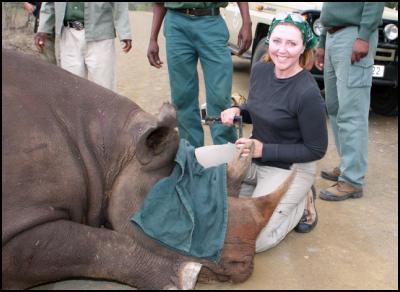Helping to save the rhino
14 January 2014
Helping to save the rhino
Research from Victoria University has revealed a way to help secure the future of an endangered species of black rhinoceros in South Africa.
Rosalynn Anderson-Lederer, who spent six months working with black rhino in KwaZulu-Natal province in south-eastern South Africa, looked at how quickly genetic variation is being lost in the endangered rhino population and discovered that the decline can be slowed, and possibly reversed.

Click for big version.
“Simply by bringing in a pair of rhinos, one male and one female, from other parts of Africa once every generation, so once every 14 years, genetic variability can be increased,” she says.
Rosalynn, who recently graduated from Victoria University with a PhD in Cell and Molecular Bioscience, says that high levels of genetic variability are important to improve chances of survival.
“If a species has low levels, it should be able to survive slight to moderate changes to the environment, or disease or injury, but may not be able to survive if it encounters more than one of these things at the same time. Species with higher levels of genetic variation tend to thrive better.”
Studies have shown that, overall, species with low levels of genetic variability are at greater risk of extinction than those with high levels.
“If genetic variation loss in endangered populations can be slowed down, it could give the population a chance to adapt to future changes in the environment or diseases,” she says.
Rosalynn, originally from San Diego, went to South Africa in 2008 and 2009, for three months at a time, to collect genetic material from the black rhinoceros.
“To bring down a black rhino in order to collect blood and tissue is an amazing feat,” she says. The rhino has to be identified from a helicopter and then “darted” with an anaesthetic.
“Once the rhino stops you have to act quickly as its metabolism is quite delicate. The veterinarian is careful and if the rhino shows any signs of distress they reverse the anaesthetic.
“If the rhino is breathing normally and sleeping, you have 20 minutes from start to finish to take enough blood and tissue and to get a radio transmitter in the horn.”
Back in Wellington, she spent a number of months testing the samples in the lab. “Extracting DNA can take anywhere from several hours to a few days, depending on how you extract it. With an endangered species, you have a limited number of samples to work with,” she adds.
The management of genetic variation is important for species that depend on human intervention for survival.
“There a number of species, both plant and animal, which would be extinct if not for human intervention,” says Rosalynn, “and there is something very rewarding about finding something that is going to help an endangered species.”
ENDS


 Science Media Centre: Carbon-storing Construction Materials – Expert Reaction
Science Media Centre: Carbon-storing Construction Materials – Expert Reaction Vegetables New Zealand: New Web-Based Tool Will Help Greenhouse Growers Switch To Geothermal Heating
Vegetables New Zealand: New Web-Based Tool Will Help Greenhouse Growers Switch To Geothermal Heating Horizon Research Limited: New Poll - New Zealanders Prefer Rail Enabled Ferries
Horizon Research Limited: New Poll - New Zealanders Prefer Rail Enabled Ferries Watercare: Watercare Gets To Work On First Permanent Non-Potable Water Tanker Filling Station In Māngere
Watercare: Watercare Gets To Work On First Permanent Non-Potable Water Tanker Filling Station In Māngere Alcohol Healthwatch: Licensing Decision Lauded For Prohibiting Buy Now Pay Later Schemes In Bottle Stores
Alcohol Healthwatch: Licensing Decision Lauded For Prohibiting Buy Now Pay Later Schemes In Bottle Stores Motor Industry Association: Vehicle Registrations Up 5.6% In December, But Year-To-Date Sales Reflect Market Challenges
Motor Industry Association: Vehicle Registrations Up 5.6% In December, But Year-To-Date Sales Reflect Market Challenges



